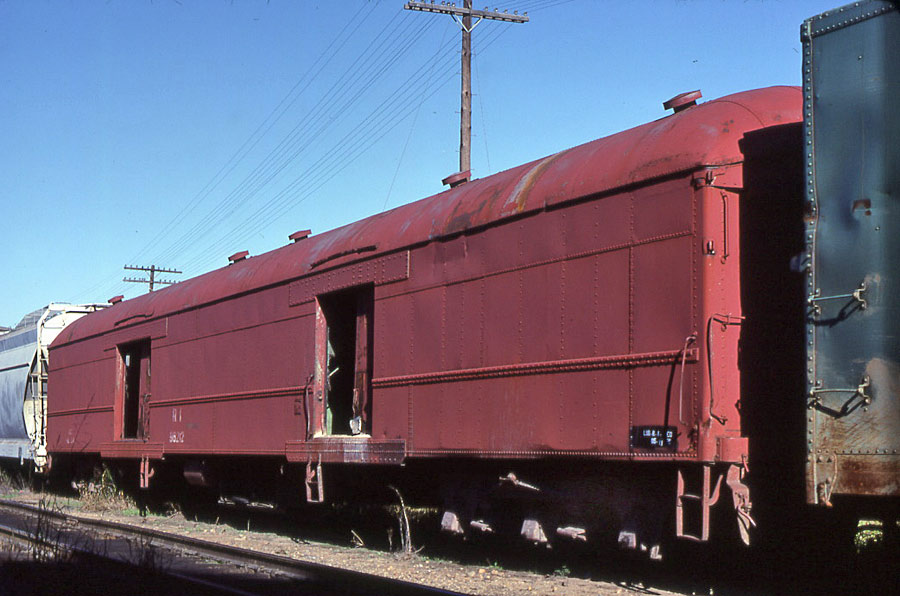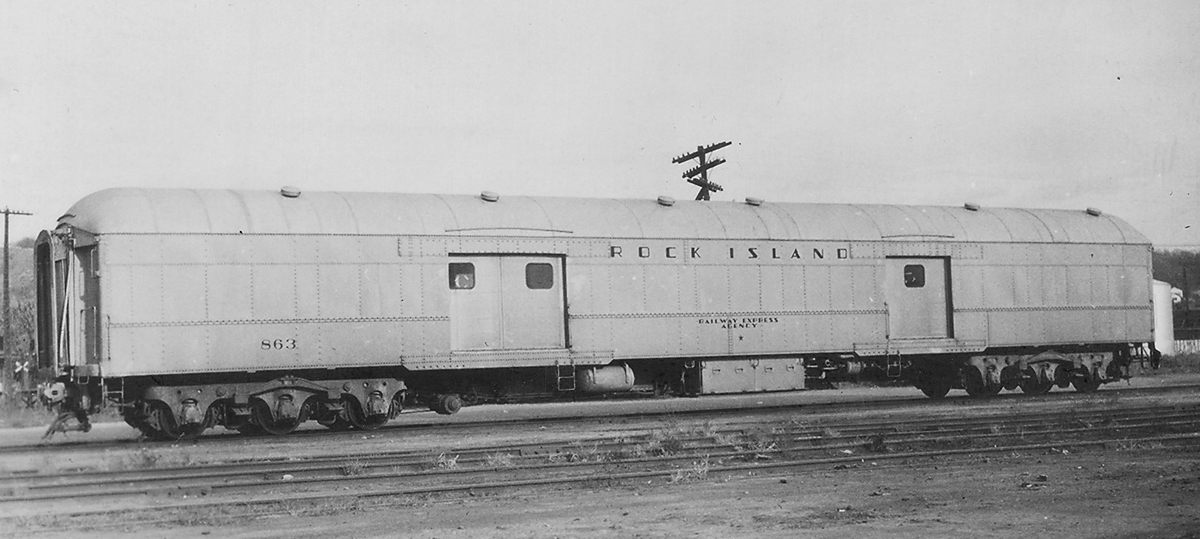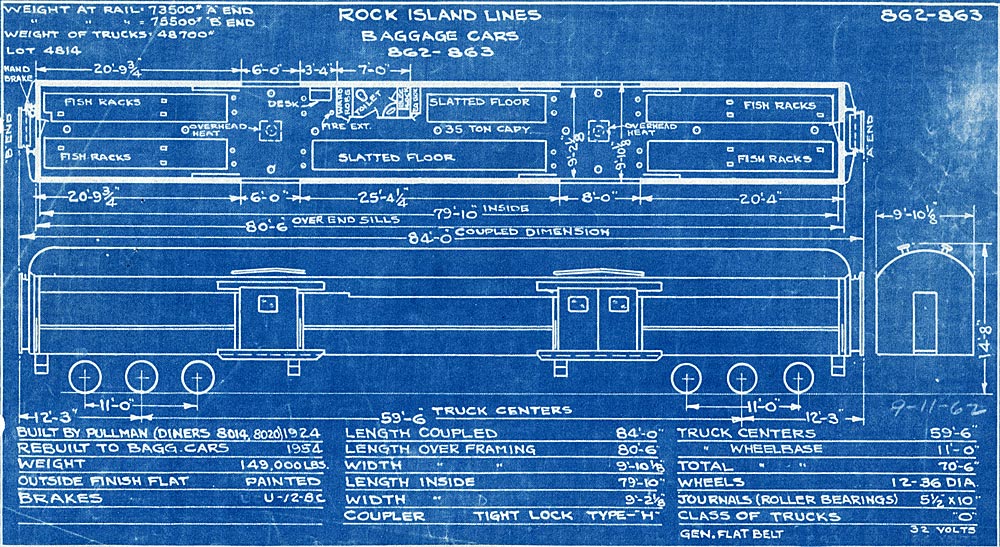Preservation Gone Awry
© 2011, 2015 by Bill Pollard

Rock Island M/W car 96212, Biddle yard, October 1978.

Baggage-express car 863, sister car to 862, when in passenger service. This is how car 96212 might
have looked when restored, if it had not been scrapped. Ray Lowry collection


Sometimes, despite the best of intentions, things just don't turn out for the best. Such is the unfortunate story of Rock Island M/W car 96212.
This car was constructed by Pullman in 1924 as Rock Island dining car 8014. In mid-1954, the car was converted to baggage car 862, equipped for high speed service with improvements such as tight-lock couplers and roller bearing wheelsets. With the end of most passenger service, this car was transitioned to maintenance of way service in 1968, where it saw another decade of hard service as M/W 96212. Its last airbrake test date was in "ED" (Eldon) in early 1978; by later that year it had migrated to Biddle where it had been bad-ordered.
A bad-order tag can be a death sentence for a railroad car, and particularly so for a 54 year old passenger car. This car had been sidelined because of a coupler defect - the drawbar mount had partially broken away from the center sill. This repair, while not difficult to manage, was not going to happen on the cash-poor Rock Island in 1978. However, the car was still basically weather tight, with a carbody in solid condition, and with the coupler sufficiently sound that there was no imminent concern about pulling the drawbar. Inquiries were made through contacts with the Rock Island, and in December 1978 the car was purchased for scrap value ($1050) by an individual on behalf of the Arkansas Railroad Club. At this time, the Arkansas Railroad Club owned a building on River Road in North Little Rock, at the end of an abandoned but still intact Missouri Pacific branchline which had once served the Big Rock stone quarry.
Interchanging a piece of maintenance of way equipment is a challenge in itself, but getting one railroad to accept another railroad's car with a bad-order tag presented an even greater obstacle. With behind-the-scenes assistance from local officials of both the Rock Island and Missouri Pacific, the car was moved from Biddle, interchanged to the Missouri Pacific, and eventually moved to the official end of track for the Big Rock branch, just east of Pike Avenue in North Little Rock. Reportedly the only exception made by the car inspectors was a bent grab iron, which was quickly repaired to their satisfaction.
While the track to the Big Rock quarry was intact, it had not been used for some time, and at the point where the line crossed Pike Avenue in North Little Rock, the flangeways had been filled with asphalt. Despite these obstacles, a MP switch engine crew late one evening received instructions to shove this car across Pike Avenue, cutting new flangeways in the asphalt-filled crossing. The move was accomplished, but the switch engine foreman left a note on the car explaining who had instructed him to move this car, perhaps to cover his actions in the event they were later called into question. A tractor was later used to move the car down the branch, with four railroad club members riding to set the hand brake as needed. In its final position, it was coupled to another Arkansas Railroad Club car, a former heavyweight Pullman car that had last served as a Missouri Pacific bunk car.
Under Arkansas Railroad Club ownership, the Rock Island car was spot painted with red primer to match its existing boxcar-red color, and roof areas sealed as necessary. Sliding door and end door mechanisms were restored to serviceable condition so that the car could be secured. The battery box door assembly was missing, and an inquiry to the Rock Island brought the information that an undamaged cover was lying along the right of way west of Biddle, where this car had previously been stored. This door was retrieved and applied to the car, painted silver with the expectation that the car itself would eventually be restored to the silver Rock Island passenger colors worn when the car was in baggage car service. In March 1980, Rock Island went out of business, and later that year and again in 1981, the railroad club was given opportunities to salvage papers from Biddle. A large quantity of paper was salvaged and stored in the baggage car.
Fast forward a decade. Priorities had changed at the Arkansas Railroad Club, and the remaining club members made a decision to escape from the liability and expense of equipment and club building ownership by evolving from a historical society into more of a social club. The club's two passenger cars had become landlocked as a result of the abandonment of the MP branch, so any removal would require more expensive truck transportation. The baggage car had also suffered several break-ins where stored Rock Island papers were trashed. A decision was made to transfer the Missouri Pacific bunk car to a rail equipment broker in northwest Arkansas, and the car was ultimately placed as part of a bank in Fayetteville, near the Frisco depot.
In the case of the Rock Island car, the outcome was less satisfactory. After some exploratory discussions, the baggage car was donated to the Cotton Belt Rail Historical Society in March 1987, with the expectation that it would be transported to Pine Bluff for inclusion in the museum which housed steam locomotive 819. In a turn of events which reportedly was not expected by Arkansas Railroad Club leadership, the car was instead scrapped on location at North Little Rock. The rare U-12-BC air brake valve and the six-wheel, roller bearing trucks were salvaged, and later appeared under a coach at the Arkansas & Missouri at Springdale, Arkansas.
Thus, despite the best efforts of quite a few people along the way, another historic piece of Rock Island rolling stock was ultimately and unnecessarily lost.
Return to Arkansas Railroad History Home Page



